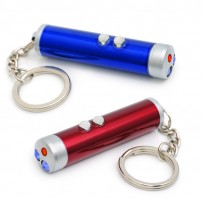Did you know that the word “laser” is an acronym for “light amplification by stimulated emission of radiation?” Consumer laser pointers can’t cut through steel or demolish a robot, but they can help you circle main points and guide your audience through a PowerPoint. It has been a staple of presentations since the 1990s, helping audience members who need to be shown the way. So, where did it come from? And how does it work?
From the Desk of Einstein
The actual inventor of the laser is debatable, but all can agree the concept originally came from Albert Einstein, who was interested in light waves but didn’t go as far as to invent it. In 1958 at Bell Labs, the first theory to produce lasers was created. A race began to invent it, with several contenders battling for the laser throne. Who won? No one knows. Honestly. In 1960, Theodore Maiman at Hughes Aircraft used a ruby as a lasing medium to create “the first laser.” However, Gordon Gould (first person to even use the word laser), patented “the first laser” in 1977. Many labs, many kinds of lasers, a lot of inventors, and total chaos.
A Massive Simplification of How it Works
 Here is how it works: a laser emits light that is amplified by an emission of electromagnetic radiation. It’s sort of like an arrow being shot by an incredibly buff archer, and the buff archer’s name is Radiation. Laser pointers are weak, restricted versions of this because of a risk of optical damage when used incorrectly. They can’t exceed 5mW, though higher power green and blue laser pointing beams can be seen clearly in daylight. This makes them useful for surveying, search and rescues, and even scaring away wild animals.
Here is how it works: a laser emits light that is amplified by an emission of electromagnetic radiation. It’s sort of like an arrow being shot by an incredibly buff archer, and the buff archer’s name is Radiation. Laser pointers are weak, restricted versions of this because of a risk of optical damage when used incorrectly. They can’t exceed 5mW, though higher power green and blue laser pointing beams can be seen clearly in daylight. This makes them useful for surveying, search and rescues, and even scaring away wild animals.
Presentations + Laser Pointers 4 Ever
Laser technology became cheap, affordable, and ubiquitous in the 90’s. This made them a go-to choice for presenters, especially with clunky overhead projectors that used data-heavy slides. Cats and audience members alike love handheld laser pointers; even 20 years later, they are still widely used.
Beware!
They may look like a party, and are used at parties, but restrictions on laser pointers are strict because of eye damage that occurs when pointed directly at the retina (on purpose or accidentally). Unless you want to be arrested and live in jail forever, never point a laser during a concert, sporting event, at airplanes, cars, or police officers.
The future for consumer laser pointers continues to develop, with the potential use of holograms on the horizon. Who knows? Maybe 3D laser presentations are just around the corner.
Question: Have you ever used a laser pointer with your presentation?
